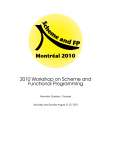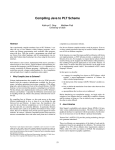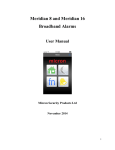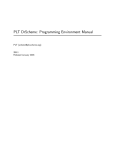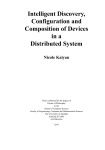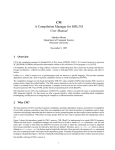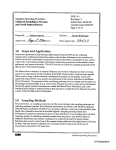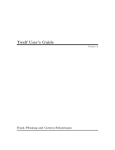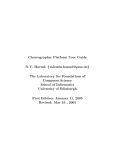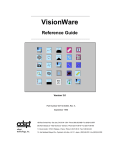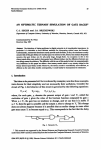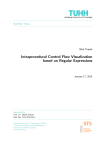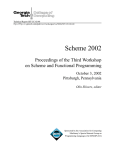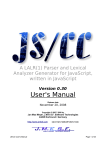Download Lexer and Parser Generators in Scheme
Transcript
Lexer and Parser Generators in Scheme
Scott Owens
Matthew Flatt
University of Utah
Olin Shivers
Benjamin McMullan
Georgia Institute of Technology
Abstract
The implementation of a basic L EX-style lexer generator or YACCstyle parser generator requires only textbook knowledge. The implementation of practical and useful generators that cooperate well
with a specific language, however, requires more comprehensive
design effort. We discuss the design of lexer and parser generators for Scheme, based on our experience building two systems.
Our discussion mostly centers on the effect of Scheme syntax and
macros on the designs, but we also cover various side topics, such
as an often-overlooked DFA compilation algorithm.
We base our discussion on two parsing tools, PLT and GT, and
present specific design notes on both systems along with discussion
on why certain ideas work well, and how these systems differ from
others. The PLT system most clearly demonstrates the first point
above. PLT’s novel features include an extensible regular expression language for lexing and a close interaction with the DrScheme
programming environment. The GT system most clearly illustrates
the second point. In GT, a parser’s context-free grammar is transformed through a target-language independent language and a pushdown automaton language before reaching Scheme, with potential
for optimization and debugging support along the way.
1
2
Introduction
Background
We briefly describe the essential design of L EX and YACC and how
it can fit into Scheme. We also discuss how the existing L EX- and
YACC-like systems for Scheme fit into the language.
Most general-purpose programming systems include a lexer and
parser generator modeled after the design of the L EX and YACC
tools from UNIX. Scheme is no exception; several L EX- and YACCstyle packages have been written for it. L EX and YACC are popular because they support declarative specification (with a domainspecific language), and they generate efficient lexers and parsers.
Although other parsing techniques offer certain advantages, L EXand YACC-style parsing remains popular in many settings. In this
paper, we report on the design and implementation of L EX- and
YACC-style parsers in Scheme. Scheme’s support for extensible
syntax makes L EX- and YACC-style tools particularly interesting.
2.1
LEX and YACC
A text processor is constructed with L EX and YACC by specifying
a lexer that converts a character stream into a stream of tokens with
attached values, and by specifying a parser that converts the token/value stream into a parse tree according to a context-free grammar (CFG). Instead of returning the parse tree, the parser performs
a single bottom-up computation pass over the parse tree (synthesized attribute evaluation) and returns the resulting value, often an
abstract-syntax tree (AST). L EX generates a lexer from a regexp
DSL, and YACC generates a parser from a CFG DSL.
• Syntax allows the DSL specifications to reside within the
Scheme program and to cooperate with the programming environment. We can also lift Scheme’s syntactic extensibility
into the DSL, making it extensible too.
• Syntax supports code generation through a tower of languages. Breaking the translation from grammar specification
to Scheme code into smaller steps yields a flexible and clean
separation of concerns between the levels.
regexps −→
L EX
↓
chars −→
lexer
tokens
−→
YACC
↓
←− CFG
parser
−→ AST
From a programmer’s perspective, building a text processor takes
three steps:
Additionally, lexer and parsers are examples of language embedding in general, so this paper also serves as an elaboration of the
“little languages” idea [13].
• Creation of regular expressions (regexps) that describe the token structure. These are typically defined outside the lexer
with a regexp abbreviation facility.
• Creation of the lexer by pairing the regexps with code to generate tokens with values.
• Creation of the parser with a CFG that describes the syntax, using token names as non-terminals. Attribute evaluation
code is directly attached to the CFG.
Permission to make digital or hard copies, to republish, to post on servers or to redistribute to lists all or part of this work is granted without fee provided that copies are
not made or distributed for profit or commercial advantage and that copies bear this
notice and the full citation on the first page. To otherwise copy or redistribute requires
prior specific permission.
Fifth Workshop on Scheme and Functional Programming. September 22, 2004, Snowbird, Utah, USA. Copyright 2004 Owens, Flatt, Shivers, and McMullan.
A lexer is occasionally useful apart from a parser and can choose
to produce values other than special token structures. Similarly, a
41
Figure 1 Lexical scope in a lexer
Figure 2 Source highlighting of a runtime error
parser can operate without a lexer or with a hand-written lexer that
returns appropriate token structures. Nevertheless, L EX and YACC
(and the lexers and parsers they generate) are used together in most
cases.
Operationally, L EX converts the regexps into a deterministic finite
automaton (DFA) and YACC converts the CFG into a push-down
automaton (PDA). These conversions occur at lexer and parser generation time. The DFA can find a token in linear time in the length
of the input stream, and the PDA can find the parse tree in linear
time in the number of tokens. The transformation from regexps and
CFG can be slow (exponential in the worst case), but performing
these computations once, at compile time, supports deployment of
fast text-processing applications.
2.2
parser and lexer actions. Check Syntax draws arrows between statically apparent binding and bound variable occurrences and can αrename these variables. It also provides assistance with the declarative part of a parser specification, correlating non-terminals on the
right and left of a production and correlating uses of $n attribute
references with the referent terminal or non-terminal.
2.3
Previous Work
We categorize the many lexer and parser generators written in
Scheme as follows: those that do not use s-expression syntax, those
that use s-expressions but do not provide a syntactic form for integrating the specifications with Scheme programs, and those that do
both.
The Scheme Way
UNIX L EX and YACC operate in a file-processing batch mode.
They read a lexer or parser specification from an input file and write
a program to an output file. With batch compiled programming languages, e.g., C or Java, this is the best that can be done. The build
system (such as a makefile) is told how to convert the specification
file into a code file, and it does so as needed during batch compilation.
Danny Dubé’s SILex lexer generator [6] fits in the first category,
closely duplicating the user interface of L EX. Mark Johnson’s
LALR parser generator [10] and the SLLGEN system [9] fall into
the second category. Both provide a function that consumes a
list structure representing a grammar and returns a parser. With
Scheme’s quasiquote mechanism, programmers can write the grammar in s-expression format and generate grammars at run time. This
approach sacrifices the efficiency of computing the parser from the
grammar at compile time and also hampers compile-time analysis
of the CFG and attached code.
The file-processing approach does not fit naturally into Scheme’s
compilation model. Instead of using an external batch compilation manager, most Scheme programs rely on a compilation strategy provided by the language implementation itself. The simplest
way to cause these compilation managers to execute a Scheme program is to package it in a macro. The compilation manager then
runs the program while it macro-expands the source. Specifically,
when a lexer or parser generator is tied into the Scheme system
via a macro, the macro expander invokes the regexp or grammar
compiler when the internal compilation system decides it needs to.
Each of the PLT and GT parser tools syntactically embeds the lexer
or parser specification inside the Scheme program using lexer and
parser macros. This solution easily supports L EX- and YACC- style
pre-computation without breaking Scheme’s compilation model.
Dominique Boucher’s original lalr-scm system [3] falls into the
second category, encoding the CFG in an s-expression. It uses
DeRemer and Pennello’s LALR algorithm [5] to process the grammar and, unlike previous tools, supports ahead-of-time compilation of the CFG. However, it does not integrate specifications into
Scheme via macros, instead it provides a compiler that maps CFG
s-expressions to a parse table. The table is printed out and incorporated into source code along with an interpreter to drive the parser.
In this sense, the parser development cycle resembles YACC’s.
Boucher’s original implementation is also missing some important
functional elements, such as associativity declarations to resolve
shift/reduce ambiguities.
With a macro-based approach, a lexer or parser specification can
appear in any expression position. Hygiene then ensures that variables in embedded Scheme expressions refer to the lexically enclosing binding (see Figure 1). Furthermore, the embedded code automatically keeps source location information for error reporting, if
the underlying macro expander tracks source locations as does PLT
Scheme’s (see Figure 2). A stand-alone specification achieves neither of these goals easily.
Design particulars aside, Boucher’s source code was influential,
and his complete, debugged, and portable LALR implementation
provided a foundation for several later efforts in our third category. Serrano’s Bigloo Scheme system [11] incorporated Boucher’s
implementation, with extensions. Critically, Bigloo uses macros
to embed the parser language directly into Scheme. (Bigloo also
supports embedded lexers.) Shivers and his students subsequently
Source-location tracking and lexical scoping lets refactoring tools,
such as DrScheme’s Check Syntax, assist programmers with their
42
adopted Serrano’s code at Georgia Tech for compiler work, and then
massively rewrote the code (for example, removing global-variable
dependencies and introducing record-based data structures for the
ASTs) while implementing the GT parser design described in this
paper. Boucher has addressed the above concerns, and the current
lalr-scm system supplies a form for incorporating a CFG in a program.
In systems that support runtime regexp generation, the abstraction
power of Scheme can be applied to regexps. String-based regexps
support run-time construction through direct string manipulation
(e.g., string-append). The SRE system provides constructors
for SRE abstract syntax, allowing a Scheme expression to directly
construct an arbitrary SRE. It also provides the (rx sre ...)
form which contains s-expressions compiled according to the SRE
syntax. Think of rx in analogy with quasiquote, but instead of
building lists from s-expressions, it builds regexps from them. The
unquote form in the SRE language returns to Scheme from SRE
syntax. The Scheme expression’s result must be a regexp value
(produced either from the AST constructors, or another rx form).
The R5 RS example in SRE notation follows.
Sperber and Thiemann’s Essence parser generator [16] also falls
into the third category, using an embedded s-expression based CFG
definition form. Instead of a YACC-style CFG to PDA compilation step, Essence uses partial evaluation to specialize a generic LR
parser to the given CFG. The partial evaluation technology removes
the need for a separate compilation step, while ensuring performance comparable to the YACC methodology. Our use of macros
lets us take a compilation-based approach to implementation—a
simpler and less exotic technology for achieving performance.
3
(define (uinteger digit )
(rx (: (+ ,digit ) (∗ "#"))))
(define (number digit )
(rx (: (? "-") ,(uinteger digit )
(? ".") (? ,(uinteger digit )))))
(define digit2 (rx (| "0" "1")))
(define digit8 (rx (| "0" ... "7")))
(define number2 (number digit2 ))
(define number8 (number digit8 ))
Regular Expressions
Defining regular expressions that match the desired tokens is the
first step in creating a lexer, but regexps are also used as a pattern
language in many other text processing tools. For example, programming languages often support regular expression matching as
a computational device over strings. Hence we first consider regexps by themselves.
3.1
A lexer cannot use the unquote approach, because a lexer must
resolve its regexps at compile time while building the DFA. Thus,
PLT and Bigloo support static regexp abstractions. In both systems, the regexp language supports static reference to a named
regexp, but the association of a regexp with a name is handled
outside of the regexp language. In Bigloo, named regexp appear in a special section of a lexer definition, as in L EX. This
prevents sharing of regexps between lexers. In PLT, a Scheme
form define-lex-abbrevs associates regexps with names. For
example, consider the define-lex-abbrevs for a simplified
uinteger2 :
Notational Convenience
Many regexp matching libraries use the POSIX regexp syntax embedded in a string. This approach requires the insertion of escape
characters into the POSIX syntax (a veritable explosion of \ characters, since \ is used as the escape character in both POSIX and
Scheme). An s-expression based regexp language fits more naturally into Scheme and can still include a form for string-embedded
POSIX syntax, if desired.
(define-lex-abbrevs
(digit2 (union "0" "1"))
(uinteger2 (repetition 1 +inf.0 digit2 ))))
SREs [14], Bigloo Regular Grammars [11, section 9], and PLT lexer
regexps all use s-expression syntax. The SRE notation is oriented
toward on-the-fly regexp matching functions and was developed for
the scsh systems programming environment [12, 15]. Bigloo Regular Grammars are designed for lexer specification, as are the PLT
lexer regexps. The PLT Scheme lexer generator uses the syntax of
Figure 3,1 and SREs use the syntax of Figure 4. Bigloo uses notation similar to SREs without the dynamic unquote operation.
3.2
Each name defined by define-lex-abbrevs obeys Scheme’s lexical scoping and can be fully resolved at compile time. Thus, multiple PLT lexers can share a regexp.
To support the entire R5 RS example, the PLT system uses macros in
the regexp language. A form, define-lex-trans, binds a transformer to a name that can appear in the operator position of a regexp. The regexp macro must return a regexp, as a Scheme macro
must return a Scheme program. The system provides libraries of
convenient regexp forms as syntactic sugar over the parsimonious
built-in regexp syntax. Of course, programmers can define their
own syntax if they prefer, creating regexp macros from any function that consumes and produces syntax objects [7][8, section 12.2]
that represent regexps.
Abstraction
To avoid unnecessary duplication of regular expressions, a regexp
language should support abstraction over regular expressions. Consider the R5 RS specification of numbers:
huinteger Ri → hdigit Ri+ #∗
This example suggests naming a regexp, such as digit8 for the
digits 0 to 7, and building a regexp producing function uinteger
that takes in, for example, digit8 and produces the regexp
uinteger8 .
Using the SRE operator names, the R5 RS example becomes:
(define-lex-trans uinteger
(syntax-rules ()
(( digit ) (: (+ digit ) (∗ "#")))))
(define-lex-trans number
(syntax-rules ()
(( digit )
(: (? "-") (uinteger digit )
(? ".") (? (uinteger digit ))))))
1 The
regexp language described in Figure 3 is new to version
299.13 of PLT Scheme. The syntax of versions 20x does not support the definition of new forms and is incompatible with other
common s-expression notations for regexps.
43
Figure 3 The PLT lexer regular-expression language
re ::= ident
; Bound regexp reference
| string
; Constant
| char
; Constant
| (repetition lo hi re)
; Repetition. hi=+inf.0 for infinity.
| (union re ...)
; General set
| (intersection re ...)
; algebra on
| (complement re)
; regexps
| (concatenation re ...)
; Sequencing
| (char-range char char)
; Character range
| (char-complement re ...) ; Character set complement, statically restricted to 1-char matches
| (op form ...)
; Regexp macro
lo ::= natural number
hi ::= natural number or +inf.0
op ::= identifier
Figure 4 The SRE regular-expression language (some minor features elided)
re ::= string
; Constant
| char
; Constant
| (** lo hi re ...)
; Repetition. hi=#f for infinity.
| (* re ...)
; (** 0 #f re ...)
| (+ re ...)
; (** 1 #f re ...)
| (? re ...)
; (** 0 1 re ...)
| (string)
; Elements of string as char set
| (: re ...)
; Sequencing
| (| re ...)
; Union
| (& re ...)
; Intersection, complement, and difference
| (~ re)
; statically restricted
| (- re re ...)
; to 1-char matches
| (/ char ...)
; Pairs of chars form ranges
| (submatch re ...) ; Body is submatch
| ,exp
; Scheme exp producing dynamic regexp
| char-class
; Fixed, predefined char set
lo ::= natural number
hi ::= natural number or #f
char-class ::= any | none | alphabetic | numeric | ...
Figure 5 Illustrative fragment of SRE type system
(define-lex-abbrevs
(digit2 (| "0" "1"))
(digit8 (| "0" ... "7"))
(number2 (number digit2 ))
(number8 (number digit8 )))
T ::= 1 | n
` char : 1
` re1 : 1 · · · ` rem : 1
` (| re1 . . . rem ) : 1
The define-lex-trans and define-lex-abbrevs forms
are macro-generating macros that define each given name
with a define-syntax form.
The regexp parser uses
syntax-local-value [8, section 12.6] to locates values for these
names in the expansion environment. Unfortunately, many common regexp operator names, such as + and ∗, conflict with built-in
Scheme functions. Since Scheme has only one namespace, some
care must be taken to avoid conflicts when importing a library of
regexp operators, e.g., by prefixing the imported operators with :
using the prefix form of require [8, section 5.2].
3.3
` re1 : t1 · · · ` rem : tm
` (∗ re1 . . . rem ) : n
` re1 : 1 · · · ` rem : 1
` (& re1 . . . rem ) : 1
` re1 : t1 · · · ` rem : tm
` (| re1 . . . rem ) : n
Intuitively, a regexp has type 1 iff it must match exactly one character and type n if it can match some other number of characters.
Regexps with misapplied character set operations have no type.
Figure 5 presents the type system for ∗, &, |, and char SREs—
the rules for the polymorphic | are most interesting. The macro
that processes SREs, rx, typechecks regexps that contain no , exp
forms. For dynamic regexps, it inserts a check that executes when
the regexp is assembled at run time.
Static Checking
Both the SRE system and the PLT lexer generator statically check
regexps. The SRE language supports a simple type inference mechanism that prevents character set operations, such as intersection
(&), from being misapplied to regexps that might accept more or
less than a single character. This system has two types: 1 and n.
44
The PLT lexer regexp language also check character set operations.
Instead of using a separate typechecking pass, it integrates the computation with the regexp parsing code. Not only must the lexer
generator reject mis-applications of character set primitives, but it
must internally group character set regexps into a specialized character set representation. In other words, (| "a" (| "b" "c")) is
internally represented as (make-char-set ’("a" "b" "c")).2
The DFA-construction algorithm usually operates on only a few
characters in each set, whereas it considers each character in a union
regexp individually. Thus the character set grouping yields a requisite performance enhancement.
(complement "x") matches any string except for the single character string "x", including multiple character strings like "xx".
3.4
(| (: (& alphabetic (~ "b"))
(∗ alphabetic ))
(: "b" (& alphabetic (~ "a"))
(∗ alphabetic ))
(: "ba" (& alphabetic (~ "d"))
(∗ alphabetic )))
The following regexp matches any sequence of letters, except for
those that start with the letters b-a-d (using a SRE-like sugaring of
the PLT regexp syntax with & generalized to arbitrary regexps).
(& (+ alphabetic )
(complement (: "bad" any-string )))
The equivalent regexp using only the usual operators (including intersections on character sets) is less succinct.
Summary
Even though a lexer generator must resolve regular expressions statically, its regexp language can still support significant abstractions.
Syntactic embedding of the regexp language, via macros, is the
key technique for supporting programmer-defined regexp operators.
The embedded language can then have static semantics significantly
different from Scheme’s, as illustrated by the regexp type system.
4
The formal specification more closely and compactly mirrors the
English specification when using complementation and intersection. We have used this idiom to exclude certain categories of
strings from the longest-match behavior of the lexer in specific
cases.
Lexer Generator
After defining the needed regexps, a programmer couples them with
the desired actions and gives them to the lexer generator. The resulting lexer matches an input stream against the supplied regexps.
It selects the longest match starting from the head of the stream and
returns the value of the corresponding action. If two of the regexps
match the same text, the topmost action is used.
As another example, a C/Java comment has the following structure:
/* followed by a sequence of characters not containing */ followed
by */. Complementation allows a regexp that directly mirrors the
specification.
(: "/∗"
(complement (: any-string "∗/" any-string ))
"∗/")
A lexer is expressed in PLT Scheme with the following form:
(lexer (re action ) ...)
The regexp (: any-string "∗/" any-string ) denotes all
strings that contain */, so (complement (: any-string "∗/"
any-string )) denotes all strings that do not contain */. Notice that (complement "∗/") denotes all strings except the string
"∗/" (including strings like "a∗/"), so it is not the correct expression to use in the comment definition. For a similar exercise, consider writing the following regexp without complement or intersection.
The lexer form expands to a procedure that takes an input-port and
returns the value of the selected action expression.
The PLT lexer generator lacks the left and right context sensitivity
constructs of L EX. Neither feature poses a fundamental difficulty,
but since neither omission has been a problem in practice, we have
not invested the effort to support them. Cooperating lexers usually
provide an adequate solution in situations where left context sensitivity would be used (encoding the context in the program counter),
and right context sensitivity is rarely used (lexing Fortran is the prototypical use). The Bigloo lexer supports left context sensitivity, but
not right.
4.1
(& (: (∗ "x") (∗ "y"))
(: any-char any-char any-char any-char ))
4.2
Lexer Actions
A lexer action is triggered when its corresponding regexp is the
longest match in the input. An action is an arbitrary expression
whose free variables are bound in the context in which the lexer
appears. The PLT lexer library provides several variables that let
the action consult the runtime status of the lexer.
Complement and Intersection
In Section 3.2, we noted that a regexp language for lexers has different characteristics than regexp languages for other applications
in that it must be static. In a similar vein, lexer specification also
benefits from complement and intersection operators that work on
all regexps, not just sets of characters. The PLT lexer generator
supports these, as does the lexer generator for the DMS system [2].
One such variable, input-port , refers to the input-port argument
given to the lexer when it was called. This variable lets the lexer
call another function (including another lexer) to process some of
the input. For example,
Intersection on character sets specializes intersection on general
regexps, but complement on character sets is different from complement on general regexps, even when considering single character regexps. For example, the regexp (char-complement
"x") matches any single character except for #\x. The regexp
(define l
(lexer
((+ (or comment whitespace ))
(l input-port ))
...))
2 To handle the large character sets that can arise with Unicode
codepoints as characters, the character set representation is actually
a list of character intervals.
instructs the lexer to call l , the lexer itself, when it matches whitespace or comments. This common idiom causes the lexer to ignore
45
whitespace and comments. A similar rule is often used to match
string constants, as in
A few enhancements render Brzozowski’s approach practical. First,
the regexp constructors use a cache to ensure that equal regexps
are not constructed multiple times. This allows the lexer generator to use eq? to compare expressions during the DFA construction. Next, the constructors assign a unique number to each regexp,
allowing the sub-expressions of a union operation to be kept in a
canonical ordering. This ordering, along with some other simplifications performed by the constructors, guarantees that the lexer
generator identifies enough regexps together that the DFA building
process terminates. In fact, we try to identify as many regexps together as we can (such as by canceling double complements and so
on) to create a smaller DFA.
(#\" (string-lexer input-port ))
where string-lexer recognizes the lexical structure of string
constants.
The lexeme variable refers to the matched portion of the input. For
example,
(number2 (token-NUM (string->number lexeme 2)))
converts the matched number from a Scheme string into a Scheme
number and places it inside of a token.
With modern large characters sets, we cannot efficiently take the
derivative of a regexp with respect to each character. Instead, the
lexer generator searches through the regexp to find sets of characters that produce the same derivative. It then only needs to take
one derivative for each of these sets. Traditional lexer generators
compute sets of equivalent characters for the original regexp. Our
derivative approach differs in that the set is computed for each regexp encountered, and the computation only needs to consult parts
of the regexp that the derivative computation could inspect.
A lexer often needs to track the location in the input stream of the
tokens it builds. The start-pos and end-pos variables refer to
the locations at the start of the match and the end of the match respectively. A lexer defined with lexer-src-pos instead of lexer
automatically packages the action’s return value with the matched
text’s starting and ending positions. This relieves the programmer
from having to manage location information in each action.3
4.3
Code Generation
Owens added the derivative-based lexer generator recently. Previously, the lexer generator used a direct regexp to DFA algorithm [1,
section 3.9] (optimized to treat character sets as single positions in
the regexp). Both algorithms perform similarly per DFA state, but
the derivative-based algorithm is a much better candidate for elegant implementation in Scheme and may tend to generate smaller
DFAs. On a lexer for Java, both algorithms produced (without minimization) DFAs of similar sizes in similar times. On a lexer for
Scheme, the Brzozowski algorithm produced a DFA about 25 the
size (464 states vs. 1191) with a corresponding time difference.
Most lexer generators first convert the regexps to a nondeterministic finite automaton (NFA) using Thompson’s construction [18] and then use the subset construction to build a DFA, or
they combine these two steps into one [1, section 3.9]. The naive
method of handling complement in the traditional approach applies Thompson’s construction to build an NFA recursively over
the regexp. When encountering a complement operator, the subset
construction is applied to convert the in-progress NFA to a DFA
which is then easily complemented and converted back to an NFA.
Thompson’s construction then continues. We know of no elegant
method for handling complement in the traditional approach. However, the DMS system [2] uses the NFA to DFA and back method
of complement and reports practical results.4
4.4
Summary
Embedding the lexer generator into Scheme places the action expressions naturally into their containing program. The embedding
relies on hygienic macro expansion. To support convenient complement and intersections, we moved the lexer generator from a traditional algorithm to one based on Brzozowski’s derivative. Even
though the derivative method is not uniquely applicable to Scheme,
we found it much more pleasant to implement in Scheme than our
previous DFA generation algorithm.
The PLT lexer generator builds a DFA from its component regular
expressions following the derivative based method of Brzozowski
[4]. The derivative approach builds a DFA directly from the regexps, and handles complement and intersection exactly as it handles
union.
Given a regular expression r, the derivative of r with respect to a
character c, Dc (r), is {s | r matches cs}. The derivative of a regexp
can be given by another regexp, and Brzozowski gives a simple recursive function that computes it. The DFA’s states are represented
by the regexps obtained by repeatedly taking derivatives with respect to each character. If Dc (r) = r0 , then the state r has a transition on character c to state r0 . Given r and its derivative r0 , the lexer
generator needs to determine whether a state equivalent to r0 already
exists in the DFA. Brzozowski shows that when comparing regexps
by equality of the languages they denote, the iterated derivative procedure constructs the minimal DFA. Because of the complexity of
deciding regular language equality, he also shows that the process
will terminate with a (not necessarily minimal) DFA if regexps are
compared structurally, as long as those that differ only by associativity, commutativity and idempotence of union are considered
equal.
A CFG consists of a series of definitions of non-terminal symbols.
Each definition contains the non-terminal’s name and a sequence of
terminal and non-terminal symbols. Uses of non-terminals on the
right of a definition refer to the non-terminal with the same name
on the left of a definition. A terminal symbol represents an element
of the token stream processed by the parser.
3 The return-without-pos variable lets src-pos lexers invoke
other src-pos lexers without accumulating multiple layers of source
positioning.
4 Michael Mehlich, personal communication
A parser cannot, in general, efficiently parse according to an arbitrary CFG. The bottom-up parsers generated by YACC use a lookahead function that allows them to make local decisions during parsing and thereby parse in linear time. Lookahead computation has
5
Parser Generators
A parser is built from a CFG and consumes the tokens supplied by
the lexer. It matches the token stream against the CFG and evaluates
the corresponding attributes, often producing an AST.
5.1
46
Grammars
parser or lexer, the set of valid tokens using the following forms for
tokens with values and without, respectively.
ambiguous results for some grammars (even unambiguous ones),
but the LALR(1) lookahead YACC uses can handle grammars for
most common situations. Precedence declarations allow the parser
to work around some ambiguities. Both the PLT and GT tools follow YACC and use LALR(1) lookahead with precedences.
5.2
(define-tokens group-name (token-name ...))
(define-empty-tokens group-name
(token-name ...))
Tokens
A parser imports these tokens by referencing the group names in its
tokens argument. The parser generator statically checks that every
grammar symbol on the right of a production appears in either an
imported token definition or on the left of a production (essentially
a non-terminal definition). DrScheme reports violations in terms of
the CFG, as discussed in Section 6.2.
A parser is almost completely parametric with respect to tokens
and their associated values. It pushes them onto the value stack,
pops them off it, and passes them to the semantic actions without
inspecting them. The parser only examines a token when it selects
shift/reduce/accept actions based on the tokens in the input stream’s
lookahead buffer. This is a control dependency on the token representation because the parser must perform a conditional branch that
depends on the token it sees.
The token-declaration forms additionally provide bindings for
token-creation functions that help ensure that the lexer creates token
records in conjunction with the parser’s expectations. For example, (token-x ) creates an empty token named x , and (token-y
val ) creates a non-empty token named y . Thus the single external point of token declaration keeps the token space synchronized
between multiple lexers and parsers.
Nevertheless, most parser generators, including the PLT system, enforce a specific token representation. The PLT system abstracts the
representation so that, were it to change, existing lexer/parser combinations would be unaffected. The GT system allows the token
representation to be specified on a parser-by-parser basis.
5.2.1
5.3
Tokens in GT
A parser specification contains, in addition to a CFG, directives that
control the construction of the parser at an operational level. For example, precedence declarations, in the GT tokens and PLT precs
forms, resolve ambiguities in the CFG and in the lookahead computation.
The GT parser tool is parameterized over token branch computation; it has no knowledge of the token representation otherwise.
The GT parser macro takes the name of a token-case macro
along with the CFG specification. The parser generator uses the
token-case macro in the multi-way branch forms it produces:
The PLT start form declares the non-terminal at the root of the
parse tree. When multiple start non-terminals appear, the parser
generator macro expands into a list containing one parser per start
non-terminal. Multiple start symbols easily allow related parsers
to share grammar specifications. (Most other parser generators do
not directly support multiple start symbols and instead require
a trick, such as having each intended start symbol derive from
the real start symbol with a leading dummy terminal. The lexer
produces a dummy terminal to select the desired start symbol [17,
section 10].)
(token-case token-exp
((token ...) body ...)
...
(else body ...))
The Scheme expression token-exp evaluates to a token value, and
the token elements are the token identifiers declared with the
CFG. Scheme’s macro hygiene ensures that the identifiers declared in CFG token declarations and the keys recognized by the
token-case macro interface properly.
The PLT system end form specifies a set of distinguished tokens, one of which must follow a valid parse. Often one of
these tokens represents the end of the input stream. (Other
parser generators commonly take this approach.) In contrast, GT’s
accept-lookaheads clause supports k-token specifications for
parse ends. Thus nothing in GT’s CFG language is specifically
LALR(1); it could just as easily be used to define an LR(k) grammar, for k > 1. Although the current tools only process LALR(1)
grammars, the CFG language itself allows other uses.
The token-case macro has a free hand in implementing the primitive token-branch computation. It can produce a type test, if tokens
are Scheme values such as integers, symbols, and booleans; extract
some form of an integer token-class code from a record structure, if
tokens are records; or emit an immediate jump table, if tokens are
drawn from a dense space such as the A SCII character set.
The token-case branch compiler parameterizes the CFG to
Scheme compiler. This ability to factor compilers into components that can be passed around and dropped into place is unique
to Scheme. Note, also, that this mechanism has nothing to do with
core Scheme per se. It relies only on the macro technology which
we could use with C or SML, given suitable s-expression encodings.
5.2.2
Parser Configuration
GT’s CFG language makes provision for the end-of-stream (eos)
as a primitive syntactic item distinct from the token space. An
accept-lookaheads specification references eos with the #f literal, distinguishing the concept of end-of-stream (absence of a token; a condition of the stream itself) from the set of token values.
This was part of clearly factoring the stream representation (e.g., a
list, a vector, an imperative I/O channel) from the token representation (e.g., a record, a character, a symbol) and ensures that the token
space is not responsible for encoding a special end-of-stream value.
Tokens in PLT
The PLT parser generator sets a representation for tokens. A token
is either a symbol or a token structure containing a symbol and a
value, but this representation remains hidden unless the programmer explicitly queries it. A programmer declares, outside of any
47
Figure 6 The PLT parser language
parser ::= (parser-clause ...)
parser-clause ::=
|
|
|
|
|
|
|
|
|
(start nterm ...)
(end term ...)
(tokens token-group ...)
(error scheme-exp)
(grammar (nterm rhs ...) ...)
(src-pos)
(precs (prec term ...) ...)
(debug filename)
(yacc-output filename)
(suppress)
rhs
::= ((gsym ...) [term] action)
prec
::= left | right | nonassoc
gsym
::= term | nterm
action ::= scheme-exp
filename ::= string
term, nterm, token-group ::= identifier
5.4
; Starting non-terminals
; Must follow parse only
; Declare tokens
; Called before error correction
; Defines the grammar
; Optional: Automatic source locationing
; Optional: Declare precedences
; Optional: print parse table & stack on error
; Optional: Output the grammar in YACC format
; Optional: Do not print conflict warnings
; Production with optional precedence tag
; Associativity/precedence declarator
; Grammar symbol
; Semantic action
Attribute Computation
For further convenience, the implicit-variable-prefix declaration can override the $ prefix. Thus, a handwritten parser can arrange to use implicitly-bound variables of the form val-1, val-2,
. . . , with the declaration
Each production in the grammar has an associated expression that
computes the attribute value of the parse-tree node corresponding
to the production’s left-hand non-terminal. This expression can use
the attribute values of the children nodes, which correspond to the
grammar symbols on the production’s right side. In YACC, the variable $n refers to the value of the nth grammar symbol.
(implicit-variable-prefix val-)
The $n notation is unavailable in the Bigloo parser generator. Instead, the grammar symbol’s name is bound to its value in the action. Because the same grammar symbol could appear more than
once, the programmer can choose the name by appending it to
the grammar symbol’s name with the @ character in-between. The
Bigloo design provides more naming naming control than the PLT
system, but no more control over hygiene. Additionally, it can lead
to confusion if grammar symbols or attribute bindings already contain @.
The PLT system non-hygenically introduces $n bindings in the attribute computations.
Tokens defined with
define-empty-tokens have no semantic values, so the
parser form does not bind the corresponding $n variables in the
semantic actions. The parser generator thereby ensures that a
reference to a $n variable either contains a value or triggers an
error.
Instead of requiring the $n convention, the GT design places no
restrictions on the variables bound to attribute values. For example,
the subtraction production from a simple calculator language,
(non-term exp
...
(=> ((left exp) - (right exp))
...)
5.5
Although the PLT and GT parser generators are based on YACC’s
design, both use a syntactic embedding of the parser specification
into Scheme, much as PLT’s lexer generator does. In the PLT system, a programmer writes a parser by placing a specification written
in the language shown in Figure 6 inside of a (parser ...) form.
The (parser ...) form compiles the grammar into a parse table
using LALR(1) lookahead and supplies an interpreter for the table.
These two elements are packaged together into a parser function.
The GT parser system uses the language in Figure 7 for its CFG
specifications. As in the PLT system, a CFG specification is placed
inside of a macro that compiles the CFG form into the target language. However, the GT design provides a much wider range of
implementation options than the PLT and other systems.
(- left right))
hygienically introduces the left and right bindings referenced
from the attribute computation, (- left right). A grammar
symbol without enclosing parentheses, such as -, specifies no binding, indicating to downstream tools that the token’s semantic value
may be elided from the value stack when it is shifted by the parser.
(Essentially, the empty-token specification shows up in the CFG
specification.)
As a convenience syntax, if the variable is left unspecified, as in
(=> ((exp) - (exp))
Code Generation
The GT system factors the parser tool-chain into multiple languages. The programmer writes a parser using the CFG language
and the parser generator compiles it to a Scheme implementation in
three steps. It transforms the CFG into a TLI (for “target-language
independent”) specification which it then expands to an equivalent parser in a push-down automata (PDA) language which it finally compiles into Scheme. The continuation-passing-style (CPS)
macro (cfg->pda cfg form ...) packages up the LALR com-
(- $1 $3))
then the $n convention is used. This unhygienic bit of syntactic
sugar is convenient for hand-written parsers, while the explicitbinding form provides complete control over variable binding for
hygienic macros that generate CFG forms.
48
Figure 7 The GT CFG language
cfg ::= (clause ...)
clause ::=
|
|
|
|
|
|
(tokens token-decl ...)
(non-term nterm rhs ...)
(accept-lookaheads lookahead ...)
(error-symbol ident [semantic-value-proc])
(no-skip token ....)
(implicit-variable-prefix ident)
(allowed-shift/reduce-conflicts integer-or-false)
token-decl ::=
|
|
|
token
(non token ...)
(right token ...)
(left token ...)
rhs ::= (=> [token] (elt ...)
elt ::= symbol
| (var symbol)
| (symbol)
; Declare tokens and precedence tags
; Declare a non-terminal
; Must come after parse
; Error-repair machinery
; Error-repair machinery
; Defaults to $
; Non-associative tokens
; Right-associative tokens
; Left-associative tokens
action)
; Production w/optional precedence tag
; Symbol w/unused semantic value
; Symbol binding semantic value to var
; Symbol w/implicitly bound semantic value
lookahead ::= (token ...[#f]) ; #f marks end-of-stream.
action ::= scheme-exp
symbol, nterm, token, var ::= ident
is identical to the main CFG language, except that (1) the
implicit-variable-prefix clause is removed (having done its
duty during the CFG-to-TLI expansion), and (2) variable binding is
moved from the production rhs to the semantic-action expression.
In the TLI language, the example above is rewritten to
piler machinery and performs the first two steps. It expands to
(form ... pda), where pda is the PDA program compiled from
the original cfg form. The macro pda-parser/imperative-io
takes a PDA program, along with the token-case macro other
relevant forms specifying the input-stream interface, and expands it into a complete Scheme parser. An alternate macro,
pda-parser/pure-io maps a PDA program to Scheme code using a functional-stream model; it is intended for parsing characters
from a string, or items from a list. The main parser macro simply
composes the cfg->pda macro with one of the PDA-to-Scheme
macros to get a Scheme parser; this is a three-line macro.
(=> ((exp) - (exp))
; Grammar
(lambda (left right) (- left right))) ; Scheme
As in the the main CFG language, parentheses mark grammar symbols whose semantic values are to be provided to the semantic action. The TLI language is completely independent of the target language, except for the semantic actions. In particular, TLI has nothing to do with Scheme at all. This means that the CFG can be compiled to its push-down automaton (PDA) with complete indifference
to the semantic actions. They pass through the LALR transformer
unreferenced and unneeded, to appear in its result. Because the TLI
language retains the information about which semantic values in a
production are needed by the semantic action, optimizations can be
performed on the parser in a target-language independent manner,
as we will see below.
Exporting the PDA language lets the system keep the token-stream
mechanism abstract throughout the CFG-to-PDA transformation.
The two PDA-to-Scheme macros each provide a distinct form of
token-stream machinery to instantiate the abstraction. In contrast,
the PLT system fixes the token-stream representation as a function
of no arguments that returns a token. Successive calls to the function should return successive tokens from the stream.
5.5.1
The TLI language
5.5.2
The PDA language
GT system was designed to be target-language neutral. That is,
to specify a parser in C instead of in Scheme using the CFG language, we would only need an s-expression concrete grammar for
C in which to write the semantic actions. This means that the CFGprocessing tools for the GT system are also independent of the target language and the language used for the semantic actions. Note
that Scheme creeps out of the semantic actions and into the rest of
the grammar language in only one place: the variable-binding elements of production right-hand sides. These variables (such as the
left and right variables bound in the above example) are Scheme
constructs.
A PDA program (see Figure 8) is primarily a set of states, where
each state is a collection of shift, reduce, accept and goto actions.
Shift, reduce and accept actions are all guarded by token lookahead
specifications that describe what the state of the token stream must
be in order for the guarded action to fire. A non-terminal symbol
guards a goto action. Reduce actions fire named rules, which are
declared by rule clauses; a reduction pops semantic values off the
value stack and uses its associated semantic action to compute the
replacement value.
To excise this Scheme dependency, the GT system defines a
slightly lower-level language than the CFG language defined in
Figure 7. The lower-level language (called the TLI language)
The PDA design contains several notable elements. The lookahead syntax allows for k-token lookahead, for k = 0, 1 and greater,
so the PDA language supports the definition of LR(k) parsers (al-
49
Figure 8 The PDA language
pda ::= (pda-clause ...)
pda-clause ::=
|
|
|
|
|
action ::=
|
|
|
|
|
(comment form ...)
(tokens token ...)
(state state-name action ...)
(rule rule-name non-term bindings semantic-action)
(error-symbol ident [semantic-value-proc])
(no-skip token ...)
(comment form ...)
(shift lookahead state-name)
(reduce lookahead rule-name)
(accept lookahead)
(goto non-term state-name)
(error-shift ident state-name)
lookahead ::= (token ...[#f])
bindings ::= (boolean ...)
state-name, rule-name ::= ident
token, non-term ::= ident
; Ignored
; Declare tokens
; Error-repair machinery
; Error-repair machinery
; Ignored
; Shift, reduce & accept
; actions all guarded
; by token-lookaheads.
; Goto action guarded by non-terminal
; Error-repair machinery
; #f marks end-of-stream
; #f marks a value not passed to semantic action
though our tools only handle k ≤ 1). As action-selection is orderdependent, the zero-token lookahead () is useful as a default guard.
acters, yet still assemble tokens at lexer speeds. Again, this can all
be provided completely independent of the eventual target language
by defining CPS macros that work strictly at the PDA0 level.
Also notable, the bindings element of the rule form is a list of
boolean literals, whose length determines how many semantic values are popped off the value stack. Only values tagged with a #t
are passed to the semantic action; values tagged with a #f are discarded. As an example, the reduction rule
Factoring out the PDA as a distinct language also supports multiple
producers as well as multiple consumers of PDA forms. One could
implement SLR, canonical LR and other CFG processors to target
the same language, and share common back end.
;;; ifexp ::= if <exp> then <stmt> else <stmt> fi
(rule r7 ifexp (#t
#t
#f
#t
#f
#t
#t)
(lambda (iftok exp stmt1 stmt2 fitok)
(make-ifexp exp stmt1 stmt2
(token:leftpos iftok)
;Position-tracking
(token:rightpos fitok)))) ;machinery
5.6
Summary
Although the PLT and GT parser generators follow the general design of YACC, both systems syntactically embed parser specifications in Scheme. The embedding benefits the PLT parser generator
in the same way it benefits the PLT lexer generator, whereas the GT
system takes advantage of the syntactic embedding to maximize
flexibility. In GT, the token structure is specified on a per-parser
basis through a token-case macro, avoiding any commitment to a
particular lexer/parser interface. (The PLT token strategy could be
implemented as a token-case macro.) Furthermore, the GT system provides complete freedom over naming in the grammar and
attributes, without compromising hygiene. We think GT’s attribute
naming system is superior to other Scheme parser generators, including Bigloo’s and PLT Scheme’s. By using a language tower,
the GT system can isolate details of one level from the others. This
allows, for example, easily switching between multiple PDA implementations and token stream representations with the same CFG.
The separation of the token and end-of-stream representations supports the use of different kinds of token-stream representations.
specifies a rule that will pop seven values off the stack, but only
pass five of them to the semantic action. Thus, the semantic action
is a Scheme procedure that takes only five arguments, not seven.
The bindings element allows a PDA optimizer, via static analysis, to eliminate pushes of semantic values that will ultimately be
discarded by their consuming reductions—in effect, useless-value
elimination at the PDA level. The bindings form specifies the local
data dependencies of the semantic actions. This key design point allows data-flow analysis of the PDA program without requiring any
understanding of the language used to express the semantic action,
which in turn supports strong linguistic factoring. The semantic
action s-expression could encode a C statement, or an SML expression just as easily as a Scheme expression; a PDA optimizer can
analyse and transform a PDA program with complete indifference.
A great allure of PDA computation is its sub-Turing strength, which
means that we have a much easier time analyzing PDA programs
than those written in a Turing-equivalent language. The moral
might be: always use a tool small enough for the job. We have
designed and are currently implementing a lower-level PDA0 language, which allows source-to-source optimizations such as nonterminal folding, control- and data-flow analysis, and dead-state
elision. This has the potential to make very lightweight parsing
practical, i.e., parsers that parse all the way down to individual char-
6
Taking Full Advantage of Syntax
As we have seen, syntactic embeddings of lexer and parser specifications allow the lexer and parser generator to perform the translation to DFA and PDA at compile time. The syntactic approach also
supports the debugging of parser specifications and lets the program
development environment operate on them.
50
6.1
Debugging Parsers
The GT tools also have small touches to help the programmer focus
in on the problem states. The LALR compiler leaves a simple report
in a comment at the top of the PDA form listing the names of all
conflicted states, e.g.,
Static debugging of an LR parser has two components: detecting
malformed grammars and semantic actions, and detecting grammars that do not conform to the requirements of the parsing methodology in use. The PLT system helps programmers with the former
kinds of error using the techniques mentioned in Section 5.2 and
Section 6.2. The GT system’s multi-level design gives programmers an elegant way of approaching the latter kinds of problems.
(comment (conflict-states s41 s63 s87))
The GT tools also provide a PDA analyser that filters a PDA and
produces a reduced PDA that containing only the ambiguous states
of the original program. Because we can so trivially render the PDA
as a Scheme s-expression, it is easy to comb through a PDA or otherwise interactively manipulate it using the usual suite of Scheme
list-processing functions such as filter, fold, map, any and so
forth—a luxury not afforded to YACC programmers.
Most parsing methodologies (including LL(k), LR(k), and LALR)
cannot handle all unambiguous CFGs, and each builds ambiguous
PDAs on some class of unambiguous CFGs. Analyzing and fixing
these grammars necessarily requires an examination of the item sets
associated with the conflicted states of the broken PDA—they must
be debugged at the PDA level. In most systems, including YACC
and the PLT system, these errors are debugged by printing out and
then carefully studying a report of the grammar’s ambiguous characteristic finite-state automaton (CFSA), which is essentially the
program defining the PDA.
Placing PDA static-error detection in the PDA tools, where it belongs, has another benefit. Since the LALR compiler will happily
produce an ambiguous PDA, we could produce a generalized LR
(GLR) parser simply by implementing a nondeterministic PDA as
a distinct macro from the current PDA-to-Scheme one. It would
compose with the current cfg->pda macro, handling ambiguous
grammars without complaint allowing reuse of the complex LALR
tool with no changes.
An ambiguous PDA has multiple shift/reduce/accept transitions
guarded by the same lookahead, so the check for bad grammars occurs statically in the PDA-to-Scheme macro. Because the GT parser
system factors the parser tool chain into multiple language levels,
the report machinery comes for free: the PDA program is the report. Since the LALR compiler is exported as a CPS macro, using
quote for the syntactic continuation shifts from language-level to
data structure. That is, this Scheme form (cfg->pda cfg quote)
expands to (quote pda) so the the following expression produces
an error report.
6.2
Little Languages and PDEs
The DrScheme program development environment has several features that display feedback directly on a program’s source. Specifically, DrScheme highlights expressions that have caused either a
compile-time or run-time error, and the Check Syntax tool draws arrows between binding and bound variables. Check Syntax inspects
fully expanded Scheme source code to determine arrow placements.
The action and attribute expressions inside the PLT lexer and
parser forms appear directly in the expanded code with their lexical scoping and source location information intact, so that Check
Syntax can draw arrows, and DrScheme can highlight errors as
demonstrated in Figures 1 and 2 in Section 2.2.
(pretty-print (cfg->pda cfg quote))
The PDA language includes a comment clause for the LALR compiler to record the item-set information for each state. This information is critical for human understanding of the PDA. An example
of a state generated by cfg->pda is
The lexer and parser forms expand into DFA and parse tables,
leaving out the source regular expression and CFG specifications.
Thus, DrScheme requires extra information to fully support these
forms. Run-time error highlighting is not an issue, because the regexp or grammar itself cannot cause a runtime error. The lexer and
parser forms directly signal compile-time errors (e.g., for an unbound regexp operator or terminal), including the source location
of the error, to DrScheme. As they parse the input regexp or grammar expression, each sub-expression (as a syntax object) contains
its source location, so they can conveniently signal such errors.
(state s15
(comment (items (=> exp (exp () divide exp))
(=> exp (exp () times exp))
(=> exp (exp minus exp ()))
(=> exp (exp () minus exp))
(=> exp (exp () plus exp))))
(reduce (r-paren) r11)
(reduce (semicolon) r11)
(comment (reduce (times) r11))
(shift (times) s11)
(comment (reduce (divide) r11))
(shift (divide) s12)
(comment (reduce (plus) r11))
(shift (plus) s13)
(comment (reduce (minus) r11))
(shift (minus) s14)
(reduce (#f) r11))
To inform Check Syntax of dependencies in the grammar, the
parser form emits a dummy let form as dead code, along with
the parse table and actions. The let includes a binding for each
non-terminal and token definition, and its body uses each grammar
symbol that occurs on the right of a production. The let introduces a new scope for all of the non-terminals and tokens, ensuring
that they do not interfere with outside identifiers of the same name.
The parser form generates the following let for the example in
Figure 9.
A comment clause lists the kernel set of the state’s items. The item
comments are grammar productions with () allowed on the righthand sides to mark the item cursor. (We did not use the traditional
dot marker ‘.’ for obvious reasons.) The LALR compiler comments
out ambiguous actions that are resolved by precedence, associativity, or the allowed-conflict-count declaration. State s15 has four of
these. Had one of them not been resolved by the LALR macro,
the resulting PDA would be ambiguous, causing the PDA macro to
report a static error that the programmer would have to debug.
(let ((exp void )
(NUM void )
(− void )
(EOF void ))
(void NUM exp − exp ))
51
Figure 9 Locating the uses of a token and a non-terminal
7
References
[1] A. A. Aho, R. Sethi, and J. D. Ullman. Compilers: Principles,
Techniques and Tools. Addison-Wesley, 1986.
[2] I. Baxter, C. Pidgeon, and M. Mehlich. DMS: Program transformations for practical scalable software evolution. In International Conference on Software Engineering, 2004.
[3] D. Boucher. A portable and efficient LALR(1) parser
generator for Scheme. http://www.iro.umontreal.ca/
~boucherd/Lalr/documentation/lalr.html.
[4] J. A. Brzozowski. Derivatives of regular expressions. Journal
of the ACM, 11(4):481–494, October 1964.
[5] F. DeRemer and T. Pennello. Efficient computation of
LALR(1) look-ahead sets. ACM Trans. Program. Lang. Syst.,
4(4):615–649, 1982.
[6] D. Dubé.
~dube/.
Figure 10 Correlating an action with the grammar
SILex.
http://www.iro.umontreal.ca/
[7] R. K. Dybvig, R. Hieb, and C. Bruggeman. Syntactic abstraction in Scheme. Lisp and Symbolic Computation, 5(4):295–
326, 1993.
[8] M. Flatt. PLT MzScheme: Language Manual, 2004. http:
//download.plt-scheme.org/doc/mzscheme/.
[9] D. P. Friedman, M. Wand, and C. P. Haynes. Essentials of
Programming Languages. The MIT Press, Cambridge, Massachusetts, 2001.
[10] M. Johnson.
Software.htm.
http://cog.brown.edu:16080/~mj/
[11] M. Serrano. Bigloo: A “practical Scheme compiler”,
2004. http://www-sop.inria.fr/mimosa/fp/Bigloo/
doc/bigloo.html.
[12] O. Shivers. A scheme shell. Higher-order and Symbolic Computation. to appear.
[13] O. Shivers. A universal scripting framework, or lambda: the
ultimate “little language”. In Concurrency and Parallelism,
Programming, Networking, and Security, volume 1179 of
Lecture Notes in Computer Science, pages 254–265. Springer,
1996.
We use a different approach for the situation shown in Figure 10.
The parser generator wraps the action with a lambda that binds the
$3 . To cause Check Syntax to draw an arrow, the lambda’s $3 parameter uses the source location of the referent grammar symbol.
With a GT-style hygienic naming option, we would use the identifier supplied with the grammar symbol in the lambda instead, and
Check Syntax could then draw the arrow appropriately to the binder.
Furthermore, α-renaming could be used to change the name. This
illustrates that hygienic macros interact more naturally with programming tools, and not just with other macros.
[14] O. Shivers. The SRE regular-expression notation. http://
www.cs.gatech.edu/~shivers/sre.txt, 1998.
[15] O. Shivers and B. Carlstrom.
The scsh manual.
ftp://www-swiss.ai.mit.edu/pub/su/scsh/
scsh-manual.ps.
[16] M. Sperber and P. Thiemann. Generation of LR parsers
by partial evaluation. ACM Trans. Program. Lang. Syst.,
22(2):224–264, 2000.
Like any compiler, a macro that processes an embedded language
must respect that language’s dynamic semantics by generating code
that correctly executes the given program. Also like any compiler,
the macro must implement the language’s static semantics. It can
do this by performing the requisite static checking itself, as in the
SRE type system and the PLT parser form’s check for undefined
grammar symbols, or it can arrange for statically invalid source programs to generate statically invalid target programs. In this case,
the macro effectively re-uses the target language’s static checking.
This is how the parser form handles unbound $n identifiers, by
letting Scheme’s free variable detection catch them. Even for the
static properties checked directly by the macro, it might need to
emit annotations (such as the let mentioned above) to preserve
static information for tools like Check Syntax.
[17] D. R. Tarditi and A. W. Appel. ML-Yacc User’s Manual: Version 2.4, 2000. http://www.smlnj.org/doc/ML-Yacc/.
[18] K. Thompson. Programming Techniques: Regular expression
search algorithm. Communications of the ACM, 11(6):419–
422, June 1968.
52













